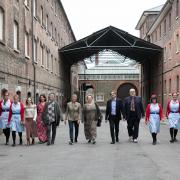Would you buy a property that's falling to bits, had bankrupted its previous owner and been condemned? Perhaps if the building in question was as beautiful as Restoration House, celebrating its 350th anniversary this year, then the answer is 'yes'
Through the keyhole at Restoration House
Would you buy a property that’s falling to bits, had bankrupted its previous owner and been condemned? Perhaps if the building in question was as beautiful as Restoration House, celebrating its 350th anniversary this year, then the answer to all those questions would be yes
A resounding ‘yes’ was certainly the reaction of Robert Tucker and his partner Jonathan Wilmot when they first set eyes on the Rochester property with a famous history.
“In the early 1990s, we were looking to buy a large, Georgian-style property in London, preferably something we could restore but were having no luck finding something we had a connection with.
“By chance, we were flicking through a copy of Country Life and saw this beautiful but exceptionally run down house for sale in Rochester,” says Robert.
Although they were quick to go and view the house, falling instantly in love with it, buying it was less straightforward. “It’s undeniably a fantastic, building but it was in a terrible state,” admits Robert.
“We actually found it difficult to find a surveyor who wouldn’t label it as condemned. Fortunately, in the end we did find someone but even then we took our time. There was just so much to consider.”
Few of us, even if funds allowed, would be willing to undertake such a mammoth restoration. The house required a large amount of expensive repair and perhaps more worryingly a previous restoration effort by Emu’s other half, Rod Hull, had resulted in his bankruptcy.
“This was certainly not something we undertook lightly,” says Robert. “In the property’s defence, however, it had several factors in its favour. The most important of these was that it was a relatively open book. Most of the problems were obvious, which in budget terms is important.
“Of course, there were some surprises, but by and large we knew what we were dealing with. The house is also quite unusual. This is a city house but one built outside the city walls. Houses such as this have traditionally been demolished or altered by urban sprawl. The historic decline in Rochester’s importance ensured that this house remained untouched, and so we were dealing with something quite unique.”
Restoration House also has a historic and literary significance. This was one of the few properties to have accommodated Charles II on his journey to reclaim the English crown in 1660. It was from this event, the 350th year anniversary of which the house has been celebrating this year that the property derived its name.
Its literary importance can be found in Dickens’ classic Great Expectations, which was published 150 years ago in December. Satis House, the run-down residence of creepy perma-bride Miss Haversham, drew its inspiration from Restoration House.
It was these connections and the uniqueness of the property that made Restoration House such a tantalising prospect. But buying the building was only the first step. Where do you begin when a house is as run down as this one was?
“From the start, we were determined that the building should be restored in as sympathetic a manner as possible,” says Robert.” I come from Australia and we don’t have as many period houses there as you have here. I love the period buildings of this county but I’m often dismayed at how some of them have been butchered and others restored in an unsympathetic way.
“With this in mind, we were both keen to restore the property back to how it was in the 17th century, when the house took its name, and to do this using techniques and materials that were in harmony with the building”
Of invaluable use in this approach was their partnership with Richard Flegg, a builder whose attitude to restoration mirrored their own (see also our feature on Master Craftsmen, June 2010).
He says: “I’ve worked on so much of this building and while doing so learnt so much about restoration. It’s quite common for period properties to be restored incorrectly. The great thing about people like Robert and Jonathan is that like me they understand that these kinds of buildings require a different approach.
“Of vital importance is the mortar used; if we had used cement then in time that would have created more problems,” explains Richard. “These buildings need to breathe and cement stops that, leading to issues such as damp and erosion.
“From the beginning we used lime mortar on the brickwork and lime plaster on the internal walls. By doing so we have ensured that not only has the house been restored sympathetically, it’s also protected from new problems in the future.”
As well as using traditional building techniques, where possible the owners also sought to use original materials. The window frames, of which there are many, are the originals. Rather than tear them out, which would have been far easier, they have instead been painstakingly repaired.
“By doing things in this way we have undoubtedly inflated the costs involved. But it’s rewarding that the house today is as close as possible, in both its look and feel, to the way it was 350 years ago” says Robert.
This approach has also reaped other rewards by helping to engage and train a new generation of skilled tradesmen who have become proficient in traditional building skills.
One such person is Jonathan Hunt, who has undertaken much of the stonemasonry work involved in the restoration. “I had just finished a degree in photography but was finding is difficult to get work. Just to earn some money I did a bit of labouring work for Richard Flegg on the property,” he explains.
“I got involved in a small way with stonemasonry and in the end I enjoyed it so much that I retrained as a stonemason. I doubt that would have happened if it wasn’t for Restoration House. Working there has been really interesting and Robert and his partner are great people to work for.”
But it’s not just the building restoration that has been done in a sympathetic way. When is comes to the fixtures and fittings of the property, the owners are just as keen to restore the house to how it would have originally looked.
“Robert and his partner came to see a play in Sevenoaks for which I had designed the costumes,” says Clare Southern. “They thought they looked so good that they asked if I could come to Restoration House and do some work for them.
“I’ve worked on part of a frieze that was in need of repair and made some of the fittings, such as blinds, for them too. It’s a very enjoyable job. Although they are keen on authenticity they allow me to be creative and that’s wonderful on a job such as this.”
When is comes to internal decoration, over the past 10 years the present owners have also painstakingly uncovered various parts of the decorative scheme which they believe was ‘run up’ in preparation for the stay of Charles II.
At a time when sparse and stripped-down Puritan tastes dominated, the use of French Grey paint, of paint effect marbling and japanning provides a fascinating insight into the beginnings of the shift towards more lavish continental tastes of the kind that would come to dominate the Restoration period.
“This is a wonderful property,” says Robert. “It’s been an honour to restore it to its former glory. It hasn’t been easy and there are times when it seemed like an impossible task and yet I’m glad that we did it.
“Not only was this building saved from further decline and possible demolition it should now be standing for generations to come.”
Restoration House
Restoration House17-19 Crow LaneRochester ME1 1RF01634 848520 (Mon-Fri 10am-5pm)
robert.tucker@restorationhouse.co.uk
Open
3 June to 24 September 2010, Thu and Fri, 10am-5pm


























